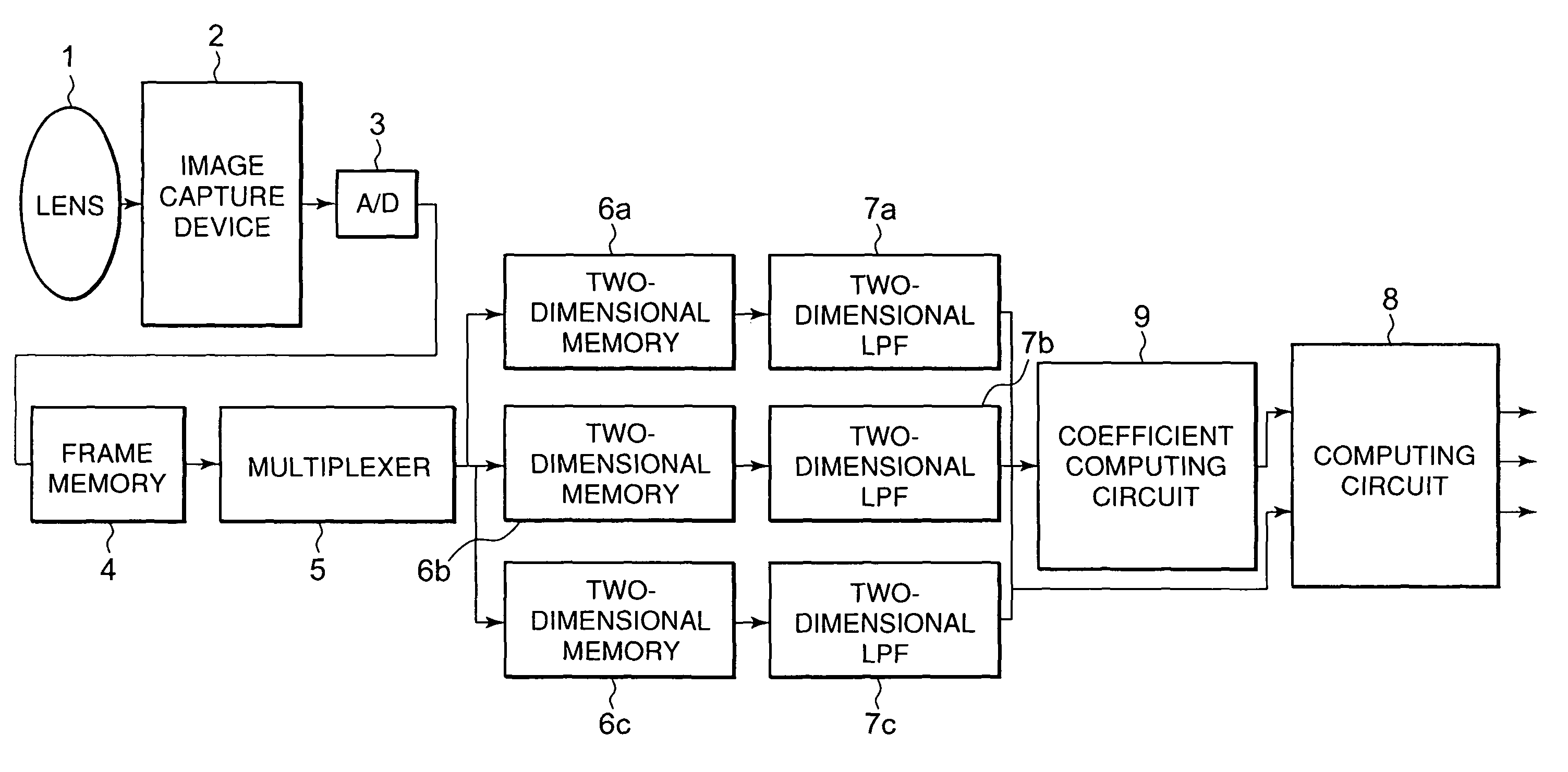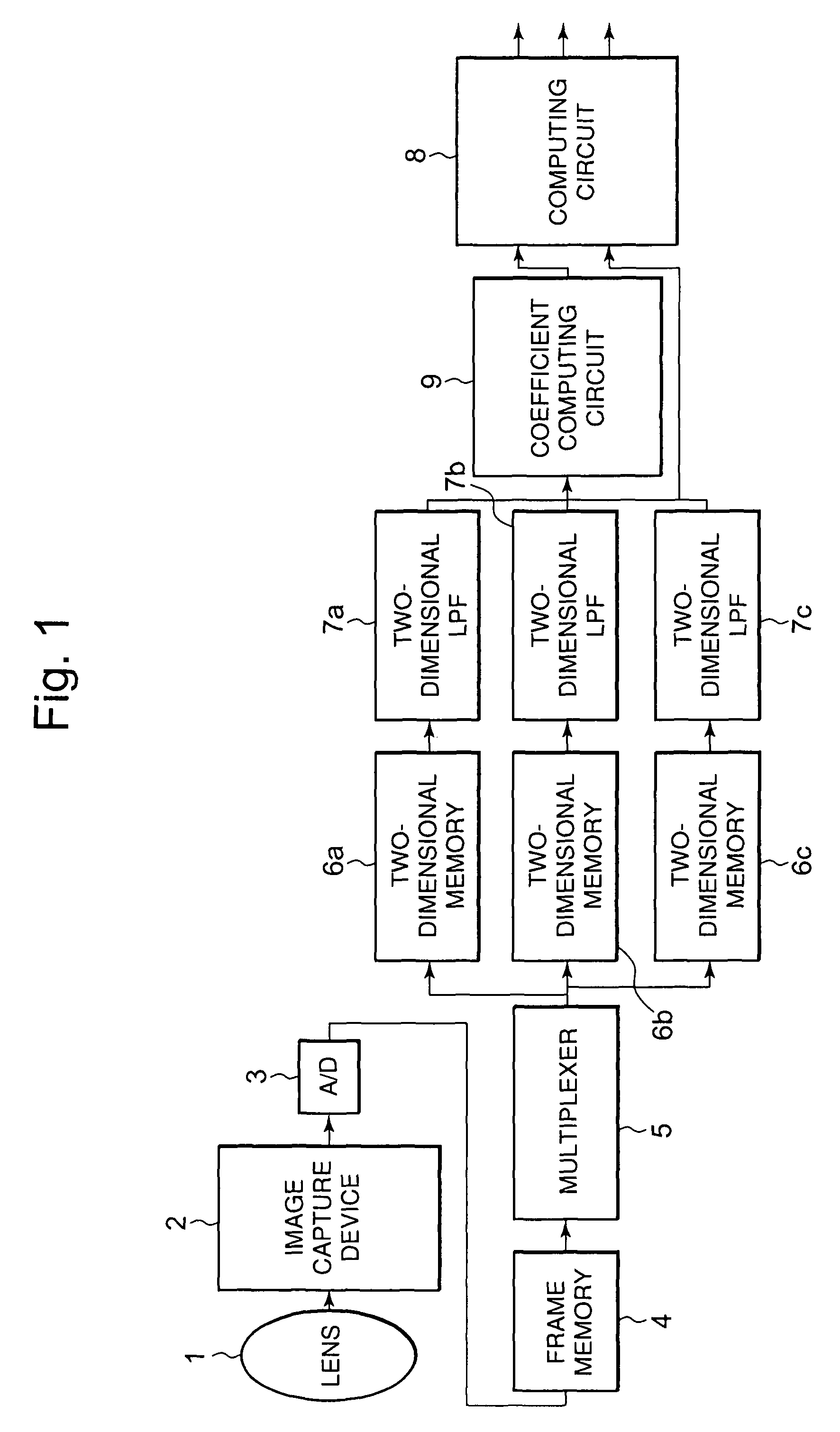Image processing device, non-capture color signal calculating device, and image processing method
a color signal and image processing technology, applied in the field of image processing devices, can solve the problems of false colors, inability to achieve sufficient resolution, and resolutions corresponding to the number of pixels cannot be achieved for any of r, g, and b colors, and achieve the effect of suppressing image quality deterioration and high practical us
- Summary
- Abstract
- Description
- Claims
- Application Information
AI Technical Summary
Benefits of technology
Problems solved by technology
Method used
Image
Examples
embodiment 1
[0046]Hereinafter, Embodiment 1 of the present invention will be described in reference to drawings. FIG. 1 is an entire block diagram illustrating Embodiment 1 of the present invention. A case will be described in which, using an image capture device composed by arranging in a Bayer pattern photoelectric transducers on which color filters of three primary colors—R color, G color, and B color—are attached at digital still image composed of R, G, and B signals each expressed by 10 bits is realized by a digital still camera.
[0047]In FIG. 1, numeral 1 denotes a lens for collecting light incident from a subject; numeral 2 denotes an image capture device for photoelectric-converting the incident light through the lens; numeral 3 denotes A / D converter for converting analog image signals outputted from the image capture device into digital image signals; numeral 4 denotes a frame memory for temporarily storing digital image signals for one frame; numeral 5 denotes a multiplexer for separat...
embodiment 2
[0068]Hereinafter, Embodiment 2 will be described in reference to drawings. The block diagram illustrating the entire configuration of Embodiment 2 is FIG. 1 as the case of Embodiment 1. Regarding the internal configuration, only the difference from Embodiment 1 is that the coefficient computing circuit 9 includes Formula 19 for calculating the coefficient K.
[0069]Next, the operation will be described. In the present embodiment, the computation in the coefficient computing circuit 9 is performed according to Formula 19.
[0070][Expression19]K=(Dr-J(m,n)-JLPF)×JLPF-HLPFM(Formula19)
[0071]Provided that K≧1, then K=1.
[0072]Here, M is expressed as M=Dr2 in Embodiment 1, which has been used for normalizing the coefficient K. In the meanwhile, in Embodiment 2, after taking in advance into consideration of characteristics such as characteristics specific to the imaging system including the optical system and sensors, and noise characteristic due to sensitivity adjustments typified by anal...
embodiment 3
[0077]Hereinafter, Embodiment 3 will be described in reference to a diagram. FIG. 9 is a block diagram illustrating the entire configuration of Embodiment 3. Regarding the internal configuration, the difference from the conventional technologies is that Formula 10 is used in the computing circuit 8 for performing computation for color interpolation and a register 10 for providing the coefficient K in Formula 10 is added to the computing circuit.
[0078]In the operation in Embodiment 3, the coefficient K in Formula 10 is directly given in advance as a constant. In this regard, Embodiment 3 is different from Embodiment 1 in which the coefficient K is dynamically calculated from Formula 9, and is different from Embodiment 2 in which a user selects the M to dynamically calculate the coefficient K from Formula 19.
[0079]The coefficient K in this case can be changed for each image in accordance with imaging conditions as in Embodiment 1 and Embodiment 2. In Embodiment 3, however, unlike Embo...
PUM
 Login to View More
Login to View More Abstract
Description
Claims
Application Information
 Login to View More
Login to View More - R&D
- Intellectual Property
- Life Sciences
- Materials
- Tech Scout
- Unparalleled Data Quality
- Higher Quality Content
- 60% Fewer Hallucinations
Browse by: Latest US Patents, China's latest patents, Technical Efficacy Thesaurus, Application Domain, Technology Topic, Popular Technical Reports.
© 2025 PatSnap. All rights reserved.Legal|Privacy policy|Modern Slavery Act Transparency Statement|Sitemap|About US| Contact US: help@patsnap.com



